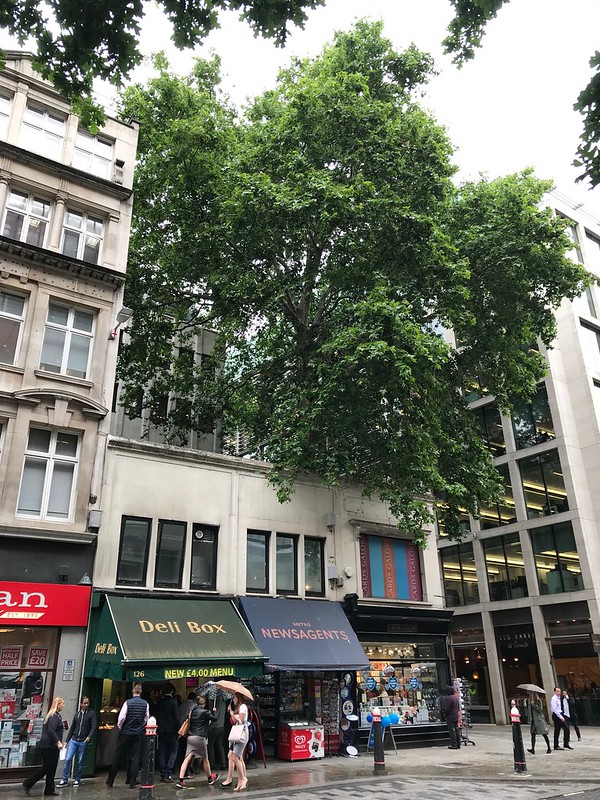Post
JOURNAL 2020 | Hiding in Plane Sight
30 Mar 2020
Matt Brown proselytizes the London plane tree, one of the great icons of London to which many are blind.
From the 2020 edition of the Journal of The London Society - complete contents and details on how to get your copy can be found here.
‘The what tree?’ That’s the usual response whenever I start listing the virtues of the London plane. As a member of the London Society, you will no doubt be familiar with this tree, but awareness is not universal, or even common. Plane trees equal blank faces. Everyone’s heard of the oak, ash, willow and beech, but the plain old plane grows outside the canopy of cognizance. This needs redressing. The London plane is one of the most common, important and easily recognised trees in the capital. It’s time to sing its praises.
Once you are aware of the plane, you see them everywhere. They are very distinctive. No other tree has that kaleidoscopic, peeling bark, supposedly adept at soaking up roadside pollutants. Those confident, grasping leaves, like hyperbolised maple, reach out in all directions, as though to shake hands with the city. And who could mistake the spiky seed balls, which dangle suggestively all through the year? The tree can be identified with ease by any of these hallmarks.
The origins of the plane are shrouded in mystery. It’s a hybrid, formed from Eurasian and American parents some time in the 17th century. The earliest surviving specimen is thought to be ‘Barney’, a mighty resident of Barnes, planted around the time of the Great Fire. Victoria Embankment was the first major thoroughfare in London to be lined with planes, in 1871. Some 121,000 can now be found in central London alone. They are synonymous with our city. The tree is called the London plane across the Commonwealth. It stands as our arboreal ambassador from Canada to New Zealand.
Why do so many Londoners not recognise these emblematic trees? It’s partly thanks to the name, which is hard to dissociate from air travel. Then, as we’ve seen, the plane is not a native species. It does not resonate through British tradition or folklore. Those of us who did not grow up in a large town or city may never have encountered one before moving to London.
Yet there’s so much to love about these trees. Few could argue against the plane as a handsome addition to the streetscape. It is one of the taller, leafier species planted along our roads. Just take a stroll along the Broad Walk, on the eastern edge of Hyde Park, which is thought to be the longest double-lined avenue of planes in Europe. It is glorious in high summer. And the plane is more than simple eye candy. According to Forest Research, in comparison to other large canopy trees, the London plane is ranked first for pollution removal and second for carbon storage. It’s both attractive and beneficial. The oldest tree in the Square Mile, a magnificent plane on Cheapside, has even affected local planning. Neighbouring buildings are restricted to two storeys – unique on Cheapside – to protect its health.
They may not play a starring role in English history like the mighty oaks that furnished the Royal Navy, or the yews that won Agincourt, but planes are finding modern uses. In Malet Street, Bloomsbury, where the planes bow like judo players, students use the trunks as pinboards. Each tree displays a thousand pinpricks, the scars of tacks that once supported the words of Marx, King or Thunberg. Over in Elephant Park, late the Heygate Estate, a few semi-mature planes of the 1970s are now engirdled with play equipment. Here, slides and climbing frames wrap around the great plants, to the delight of my three-year-old. They’ve even entered the Space Age. Along the west side of Kennington Road, the vast planes each carry the name of an Apollo astronaut. Nobody seems to remember why – including the nearby British Interplanetary Society. Look up, too, in Acton Park, where one of the trees is home to a sculpture of a python. Snakes on a plane.
Like all trees, the plane has its challenges. The plant does not hold up well in drought conditions, which could spell problems as climate change bites. Massaria, a non-native fungal disease that has doomed many planes on mainland Europe, is another problem waiting to happen. Canker stain and bacterial leaf scorch are equal threats. The plane also has its human detractors. Some people find the tree obnoxious in late spring and early summer, when spiky ‘trichome’ fibres from the leaves take to the air and cause eye irritation (the pollen/hayfever effect, by contrast, is not a huge problem with planes). Others curse the trees for blocking light or blame them for subsidence.
As we fall deeper into the climate emergency, though, London’s trees should become all the more precious and celebrated. The London plane – Platanus x hispanica – is one of the greatest assets we have to keep our city cool, drained and pure of air. Perhaps it simply needs a rebrand, from plain old plane to the Star of London tree.
Matt Brown is editor-at-large of Londonist.com, and author of Everything You Know About London is Wrong. He recently chaired a conference on plane trees on behalf of the Conservation Foundation. Contact him on matt@londonist.com if you would be interested in helping set up a London Plane Tree network to help secure the trees’ future.

